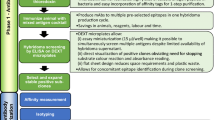Abstract
This chapter describes an epitope-directed approach to generate antipeptide monoclonal antibodies to multiple nonoverlap** protein sites using a cocktail of fusion peptides as immunogen. It provides a step-by-step protocol on how antigenic peptides on a target protein can be identified by in silico prediction and discusses considerations for final peptide selection. Each antigenic peptide (10–20 amino acids long) is displayed as three-copy inserts on the surface exposed loop of a thioredoxin scaffold protein. The corresponding DNA coding sequence specifying the tripeptide insert flanked by Gly-Ser-Gly-Ser-Gly linkers is cloned in-frame into the Rsr II site of the thioredoxin gene in the pET-32a vector. The presence of a C-terminal polyhistidine tag (His6-tag) allows the soluble fusion proteins to be purified by one-step native immobilized metal affinity chromatography (IMAC) to greater than 95% purity. Multiple thioredoxin fusion proteins are mixed in equimolar concentrations and used as an immunogen cocktail for animal immunization. The use of short antigenic peptides of known sequence facilitates direct epitope map** requiring only small mutagenesis scan peptide libraries in the multipin peptide format.
Access this chapter
Tax calculation will be finalised at checkout
Purchases are for personal use only
Similar content being viewed by others
References
Arnon R, Maron E, Sela M et al (1971) Antibodies reactive with native lysozyme elicited by a completely synthetic antigen. Proc Natl Acad Sci U S A 68:1450–1455
Niman HL, Houghten RA, Walker LE et al (1983) Generation of protein-reactive antibodies by short peptides is an event of high frequency: implications for the structural basis of immune recognition. Proc Natl Acad Sci U S A 80:4949–4953
Nilsson P, Paavilainen L, Larsson K et al (2005) Towards a human proteome atlas: high-throughput generation of mono-specific antibodies for tissue profiling. Proteomics 5:4327–4337
Trier NH, Hansen PR, Houen G (2012) Production and characterization of peptide antibodies. Methods 56:136–144
Sutcliff JG, Shinnick TM, Green N et al (1983) Antibodies that react with predetermined sites on proteins. Science 219:660–666
Green N, Alexander H, Olson A et al (1982) Immunogenic structure of the influenza virus hemagglutinin. Cell 28:477–487
Hwang LA, Phang BH, Liew OW et al (2018) Novel tools for precision medicine - monoclonal antibodies against specific p53 hot-spot mutants. Cell Rep 22:299–312
Arur S, Schedl T (2014) Generation and purification of highly-specific antibodies for detecting post-translationally modified proteins in vivo. Nat Protoc 9(2):375–395
Liew OW, Ling SSM, Lilyanna S et al (2021) Epitope-directed monoclonal antibody production using a mixed antigen cocktail facilitates antibody characterization and validation. Commun Biol 4:441
Hirani V, Yarovoy A, Kozeska A et al (2008) Expression of CYP4F2 in human liver and kidney: assessment using targeted peptide antibodies. Arch Biochem Biophys 478:59–68
Chersi A, Galati R, Ogino T et al (2002) Anti-peptide antibodies that recognize conformational differences of HLA Class 1 intracytoplasmic domain. Hum Immunol 63:731–741
Deng X, Storz U, Doranz BJ (2018) Enhancing antibody patent protection using epitope map** information. MAbs 10(2):204–209
Banik SSR, Deng X, Doranz BJ (2017) Using epitope map** to derive more value from mAbs. Genet Eng Biotechnol News 37:15
Van Regenmortel MHV (2001) Antigenicity and immunogenicity of synthetic peptides. Biologicals 29:209–213
LaVallie ER, DiBlasio EA, Kovacic S et al (1993) A thioredoxin gene fusion expression system that circumvents inclusion body formation in the E. coli cytoplasm. Biotechnology (NY) 11:187–193
Barrell PJ, Liew OW, Conner AJ (2004) Expressing an antibacterial peptide in bacteria for raising antibodies. Protein Expr Purif 33:153–159
Hammarstrom M, Hellgren N, Van den Berg S et al (2002) Rapid screening for improved solubility of small human proteins produced as fusion proteins in Escherichia coli. Protein Sci 11:313–321
Moretto N, Bolchi A, Rivetti C et al (2007) Conformation-sensitive antibodies against Alzheimer amyloid-beta by immunization with a thioredoxin-constrained B-cell epitope peptide. J Biol Chem 282:11436–11445
Rubio I, Bolchi A, Moretto N et al (2009) Potent anti-HPV immune responses induced by tandem repeats of the HPV16 L2 (20–38) peptide displayed on bacterial thioredoxin. Vaccine 27:1949–1956
Tribbick G (2002) Multipin peptide libraries for antibodies and receptor epitope screening and characterization. J Immunol Methods 267:27–35
Field CM, Oegema K, Zheng Y et al (1998) Purification of cytoskeletal proteins using peptide antibodies. Methods Enzymol 298:525–541
Jacob E, Unger R (2007) A tale of two tails: why are terminal residues of proteins exposed? Bioinformatics 23:e225–e230
Jespersen MC, Peters B, Nielsen M, Marcatili P (2017) Bepipred-2.0: improving sequence-based B-cell epitope prediction using conformational epitopes. Nucleic Acids Res 45:W24–W29
Larsen JEP, Lund O, Nielsen M (2006) Improved method for predicting linear B-cell epitopes. Immun Res 2:2
Puigbo P, Guzmen E, Romeu A, Garcia-Vallve S (2007) OPTIMIZER: A web server for optimizing the codon usage of DNA sequences. Nucleic Acids Res 35:W126–W131
Puigbo P, Romeu A, Garcia-Vallve S (2008) HEG-DB: a datase of predict highly expressed genes in prokaryotic complete genomes under translational selection. Nucleic Acids Res 36:D524–D527
Chan WT, Verma CS, Lane DP, Gan SK (2013) A comparison and optimization of methods and factors affecting the transformation of Escherichia coli. Biosci Rep 33(6):e00086
Assays of biotinylated peptides. User Note PU3-005-1 (Mimotopes, Australia). http://www.mimotopes.com/files/editor_upload/File/PeptidesAndAntibodies/PU3005-1Assays-of-Biotinylated-Peptides.PDF. Accessed 15 Nov 2021
Acknowledgements
Funding support for this work was provided under the Center Grant awarded to A. Mark Richards by the National Medical Research Council, Singapore.
Author information
Authors and Affiliations
Corresponding author
Editor information
Editors and Affiliations
Rights and permissions
Copyright information
© 2023 The Author(s), under exclusive license to Springer Science+Business Media, LLC, part of Springer Nature
About this protocol
Cite this protocol
Liew, O.W., Ling, S.S.M., Lilyanna, S., Chong, J.P.C., Ng, J.Y.X., Richards, A.M. (2023). One-Shot Generation of Epitope-Directed Monoclonal Antibodies to Multiple Nonoverlap** Targets: Peptide Selection, Antigen Preparation, and Epitope Map**. In: Cretich, M., Gori, A. (eds) Peptide Microarrays. Methods in Molecular Biology, vol 2578. Humana, New York, NY. https://doi.org/10.1007/978-1-0716-2732-7_9
Download citation
DOI: https://doi.org/10.1007/978-1-0716-2732-7_9
Published:
Publisher Name: Humana, New York, NY
Print ISBN: 978-1-0716-2731-0
Online ISBN: 978-1-0716-2732-7
eBook Packages: Springer Protocols




